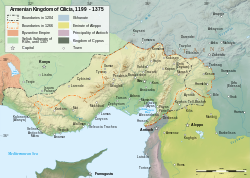Armenian Kingdom of Cilicia
The Armenian Kingdom of Cilicia,[a] (Armenian: Կիլիկիոյ Հայոց Թագաւորութիւն, romanized: Kilikiayi haykakan t’agavorut’yun) was an Armenian state formed during the High Middle Ages by Armenian refugees fleeing the Seljuk invasion of Armenia.
History change
The kingdom had its origins in the principality founded c. 1080 by the Rubenid dynasty, an alleged offshoot of the larger Bagratuni dynasty, which at various times had held the throne of Armenia. Their capital was originally at Tarsus, and later became Sis.[1] Cilicia was a strong ally of the European Crusaders, and saw itself as a bastion of Christendom in the East. It also served as a focus for Armenian nationalism and culture, since Armenia proper was under foreign occupation at the time. Cilicia's significance in Armenian history and statehood is also attested by the transfer of the seat of the Catholicos of the Armenian Apostolic Church, spiritual leader of the Armenian people, to the region.
In 1198, with the crowning of Leo I, King of Armenia of the Rubenid dynasty, Cilician Armenia became a kingdom.[2][3]
In 1226, the crown was passed to rival Hethumids through Leo's daughter Isabella's second husband, Hethum I. As the Mongols conquered vast regions of Central Asia and the Middle East, Hethum and succeeding Hethumid rulers sought to create an Armeno-Mongol alliance against common Muslim foes, most notably the Mamluks.[3] In the thirteenth and fourteenth centuries, the Crusader states and the Mongol Ilkhanate disintegrated, leaving the Armenian Kingdom without any regional allies. After relentless attacks by the Mamluks in Egypt in the fourteenth century, the Cilician Armenia of the Lusignan dynasty, mired in an internal religious conflict, finally fell in 1375.[4]
Commercial and military interactions with Europeans brought new Western influences to the Cilician Armenian society. Many aspects of Western European life were adopted by the nobility including chivalry, fashions in clothing, and the use of French titles, names, and language. Moreover, the organization of the Cilician society shifted from its traditional system to become closer to Western feudalism.[5] The European Crusaders themselves borrowed know-how, such as elements of Armenian castle-building and church architecture. Cilician Armenia thrived economically, with the port of Ayas serving as a center for East–West trade.[5]
References change
- ↑ Edwards 1987, pp. vii–xxxi, 3–288.
- ↑ Kurdoghlian 1996, pp. 43–44.
- ↑ 3.0 3.1 Nersessian, pp. 645–653.
- ↑ Ghazarian 2000, pp. 54–55.
- ↑ 5.0 5.1 Bournoutian & Atamian 1997, pp. 283–290.
Sources change
- Edwards, Robert W. (1987). The Fortifications of Armenian Cilicia, Dumbarton Oaks Studies No.23. Washington D. C.: Dumbarton Oaks, Trustees for Harvard University. pp. vii–xxxi, 3–288. ISBN 0884021637.
- Kurdoghlian, Mihran (1996). Պատմութիւն Հայոց [History of Armenia] (in Armenian). Vol. II. Athens: Հրատարակութիւն ազգային ուսումնակաան խորհուրդի [Council of National Education Publishing]. pp. 43–44.
- Nersessian, Der. The Kingdom of Cilician Armenia. pp. 645–653.
- Ghazarian, Jacob G. (2000). The Armenian Kingdom in Cilicia during the Crusades: The Integration of Cilician Armenians with the Latins (1080–1393). Routledge. pp. 54–55. ISBN 0-7007-1418-9.
- Bournoutian, George; Atamian, Ani (1997). Hovannisian., Richard G. (ed.). "Cilician Armenia" in The Armenian People From Ancient to Modern Times, Volume I: The Dynastic Periods: From Antiquity to the Fourteenth Century. Ed. Richard G. Hovannisian. New York: St. Martin's Press. pp. 283–290. ISBN 1-4039-6421-1.
Notes change
- ↑ Also known as Cilician Armenia (Armenian: Կիլիկեան Հայաստան, romanized: Giligian Hayastan), Lesser Armenia, Little Armenia or New Armenia, and formerly known as the Armenian Principality of Cilicia (Armenian: Կիլիկիայի հայկական իշխանություն, romanized: Kilikiayi haykakan ishkhanut’yun)



